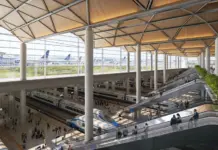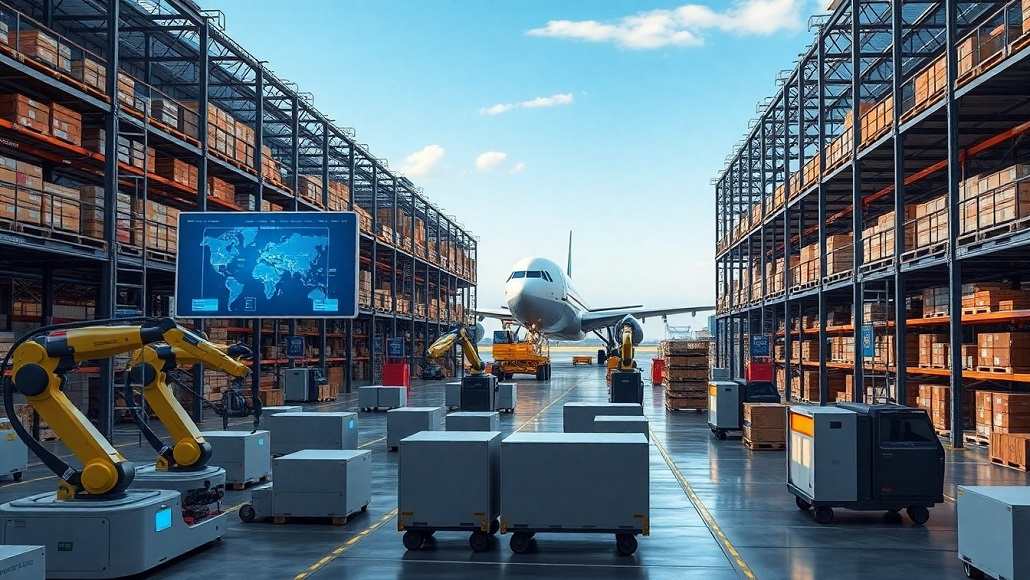Logistics and air freight are being revolutionized by the arrival of Cargo 4.0, in which data technologies and high automation are redesigning the way goods are stored, moved, and handled. Intelligent warehousing and air freight digitalization are at the core of this revolution, eliminating inefficiencies and making possible record levels of efficiency, speed, and precision. With the use of robotics, IoT, AI, and paperless logistics, Cargo 4.0 in air freight is not only transforming infrastructure but also building an uninterrupted and sustainable future for global cargoes.
Robotics and Automation in Cargo Terminals
With globalization on the rise and ever-faster technological developments, the cargo and air freight industry is also rapidly changing. The most notable of these transformations is the newly implemented robotics and automation technology in cargo terminals that is changing the historical logistical landscape.
- Robotics for Precision and Efficiency
Accuracy and efficiency are vital in the rapid-paced air freight logistics game. Robotics technologies have become game-changing instruments, allowing terminals to process cargo on a scale and with speed not possible before. The combination of Automated Guided Vehicles (AGVs), robotic arms, and sophisticated conveyor systems has changed the terminal dynamics, introducing accuracy and consistency to cargo management.
AGVs have replaced manual vehicles used to transport cargo from one area of a terminal to the next. These intelligent machines, which are loaded with sensors, cameras, and artificial intelligence software in order to make their way through complicated environments, can load and offload cargo to predetermined zones without human input. When there is no human involvement, the limits for human error are minimized but when utilizing AGVs, human error is completely eliminated. As such, safety is improved in operating within the terminal, and everything can run smoothly even at peak and busiest times.
Robotic arms do not experience fatigue like human labourers, enabling the operation to be conducted non-stop without compromising on accuracy or consistency. Also, they are able to operate on repeat 24/7 so cargo is processed and loaded onto flights at a fast enough pace to ensure everything is operationally compliant, provided that IHAs and local delivery schedules adhere to strict schedules and delivery schedules.
- Advanced Automation in Terminal Operations
The scope of automation in cargo terminals is more than robotics; it encompasses everything that is integrated into the digital ecosystem of solutions that can almost guarantee that all operating functions across logistics sitting within cargo terminals can be realized to their full advantage. Automation has enhanced efficiency, lowered costs, and replaced conventional work processes with technology-based processes.
For example, automated cargo scanning technology has replaced laborious inspection processes by providing real-time information regarding a shipment’s contents and condition. More advanced generations of automated cargo inspection systems utilize X-ray, RFID, and barcode scanning to identify and validate cargo details within seconds, eliminating time-consuming manual inspections. These are standardized and holistic technology-based systems of inspection; therefore, there is consistency for security, compliance, and operational accuracy.
Another significant example of terminal automation is the development of sophisticated digital weighbridges. These weighbridges can update records by connecting to central databases and weighing cargo with unparalleled accuracy. This reduces data input errors and allows logistics managers to monitor cargo weight and volume in real-time, a critical element of air freight capacity planning.
Moreover, IoT-based inventory systems are also important for terminal efficiency. With IoT sensors placed in storage units and cargo containers, inventory can be monitored in real-time, with parameters like location, temperature, and humidity tracked. This timely flow of information allows for activities such as re-routing shipments and manipulating storage conditions as needed to keep freight safe and in compliance with regulations.
E-Commerce Growth and Its Infrastructure Demands
E-commerce growth has shifted power dynamics in logistics and trade across the globe. With millions of packages couriered daily to meet consumer demands for same-day or next-day delivery, the infrastructure is by and large a problematic aspect in sustaining this frequency.
- The E-Commerce Boom and Its Impact
E-commerce sites have moved past borders and allowed small and medium businesses to participate in the global economy. This ripe ability to service market needs raises the concern of handling volumes of cargo not seen before. Warehousing and distribution networks, originally developed to service traditional retail supply chains, are being stressed to unprecedented levels of fulfillment service.
Retailers are increasingly turning to “fulfillment hubs” in urban areas to provide the shortest possible delivery lead times. Fulfillment hubs are the backbone of e-commerce logistics, allowing for rapid fulfillment and response to consumer needs; there are many unique capabilities and implications for air as it relates to fulfillment hubs, such as handling more advanced infrastructure with advanced technologies and integrating air freight with warehousing.
- Smarter Warehousing for E-Commerce
Warehousing and distribution networks are also transitioning to “smart warehousing” as a result of the demands of the online retail industry. Smart warehousing leverages an automated storage retrieval system (ASRS) and also provides both the automation of mobile robots and the additional benefit of using machine learning algorithms to operate processes more efficiently and manage whereby the nominal means of handling the inherent complexity of rapidly changing inventories can be monitored or tracked.
In intelligent warehouses, products are monitored the instant they enter. Intelligent systems sort and associate products with predictive analysis so that products most needed by customers are always kept handy. This minimizes picking time and enables warehouses to handle more orders without holdups.
Moreover, smart warehousing also relies on predictive demand forecasting to help determine optimal inventory levels. Companies are able to monitor customer purchasing patterns and market shifting and consistently maximize inventory levels to minimize waste and assure that the proper product is delivered at the proper time.
- Air Freight’s Role in Facilitating E-Commerce
E-commerce has also been a significant driver of growth in air freight. The global demand for rapid delivery has made air cargo a crucial component in platforms that deliver goods the same day (or even around the world). Cargo carriers and freight operators are investing in significant capacity improvements; new dedicated cargo aircraft and improved connectivity via dedicated hub networks are being implemented.
In addition, there are collaborations between big e-commerce organizations and air freight operators. The nature of these partnerships is offered priority status that allows for expedited shipments, which seems to address the needs of e-commerce consumers who want a quick, no-hassle’ delivery experience.
Digital Air Cargo Corridors and Paperless Logistics
Digital air cargo corridors and paperless logistics are part of the Cargo 4.0 revolution. The trends discussed above have created possibilities for improving transparency and efficiency in the air freight market while also supporting environmental sustainability.
- The Transition to Digital Corridors
Digital air cargo corridors are a new concept designed to create a seamless connection and integrated approach among the many logistics players, including airlines, forwarders, customs, and destination airports. Using blockchain technology, digital air cargo corridors create a single source of truth with respect to cargo movement, while offering data integrity and transparency.
By eliminating unnecessary paperwork and non-value-added manual processes that have plagued the air freight industry for years, an average digital corridor takes away the needless obstacles that will enable laser-focused logistics. Real-time tracking of cargo, with automated customs clearance, will inherently decrease transit times and the level of potential delays caused by human error or documentation issues.
- Paperless Logistics for a Sustainable Future
Conventional logistics processes are largely dependent on heavy documentation, which not only lengthens processes but also leads to environmental degradation. Companies shift towards paperless logistics to streamline their processes and lower their carbon footprint.
Electronic Air Waybills (e-AWB) have driven this digital revolution. It has replaced paper-based air waybills, enhancing the freight handling process while undertaking air freight service worldwide. Likewise, e-invoices, e-receipts, and e-manifests are on the rise towards creating a uniform landscape for cargo management.
The Role of AI and Big Data
Artificial intelligence (AI) and big data are indispensable enablers of digital air cargo corridors. As various AI algorithms scan enormous data sets, they can forecast cargo flows, analyze potential disruptions, and help recommend routing options. AI can sift through weather conditions, projected air traffic, and fuel consumption to provide the best options for cost-effective and greener flights.
Big data analytics gives logistics managers information to make specific decisions on cargo trends, opportunities, and process constraints. Data-driven decision-making allows for proactive decisions, maintaining the fluidity of cargo operations in reaction to the demands of an ever-changing market.
Conclusion
Cargo 4.0 in air freight marks a new revolutionary period in the global cargo and logistics industry. New technologies that involve the use of robots and automation are enabling the industry to be faster and more accurate in cargo terminals than ever before. The expansion in online shopping and the related infrastructure requirements have stimulated innovation in intelligent warehousing and air freight logistics. At the same time, the emergence of digital air cargo corridors and the introduction of paperless logistics are reshaping expectations on transparency, sustainability, and operational excellence.
With these trends developing further, the air freight and logistics sector will become faster, smarter, and greener. The fusion of advanced technologies with customer-oriented strategies will not only increase the reach of international trade but also redefine norms of reliability and efficiency. With the adoption of the principles of Cargo 4.0, the stakeholders along the supply chain can work towards a future that is economically and environmentally sustainable.












